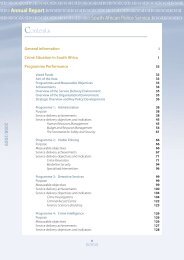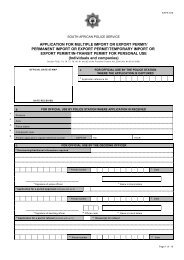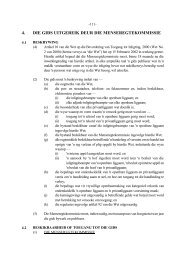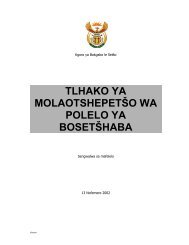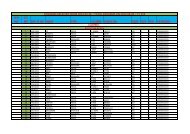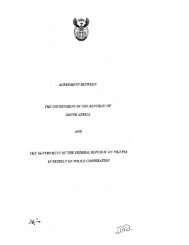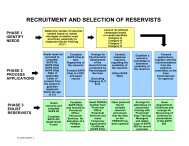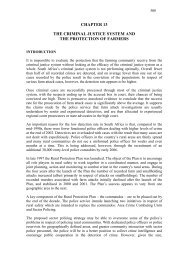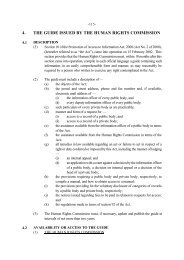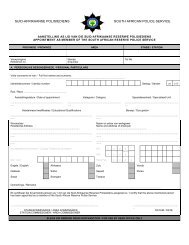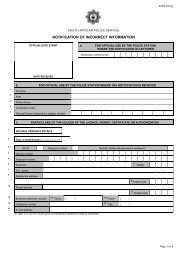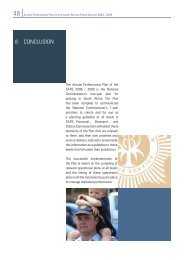Administration - Saps
Administration - Saps
Administration - Saps
You also want an ePaper? Increase the reach of your titles
YUMPU automatically turns print PDFs into web optimized ePapers that Google loves.
South African Police Service Annual Report 2011/2012<br />
2.2 Programme Performance<br />
www.saps.gov.za<br />
2.2.1 Programme 1: <strong>Administration</strong><br />
Purpose<br />
Develop policy and manage the Department, including providing administrative support.<br />
Strategic Objectives<br />
To regulate the overall management of the Department and provide centralised support services.<br />
The <strong>Administration</strong> Programme comprises the following four subprogrammes:<br />
• Ministry<br />
• Management<br />
• Corporate Services<br />
• Office Accommodation<br />
page 21
Performance Indicators and targets<br />
Table 10: Actual Performance against targets<br />
Performance Indicator Baseline 2009/10 Actual 2010/11 Actual performance against target Reason for variance<br />
Target<br />
2011/12<br />
Sub-programme: Ministry, Management, Corporate Services, Office Accommodation<br />
98,9%<br />
99,3%<br />
Percentage of personnel<br />
in terms of the approved<br />
establishment.<br />
Percentage of learners<br />
declared competent upon<br />
completion of their training<br />
in terms of the Training<br />
Provisioning Plan (TPP).<br />
(190 199 in terms<br />
of the approved<br />
establishment).<br />
88,1% (231 205<br />
members trained and<br />
203 791 members<br />
declared competent<br />
upon completion of<br />
the training).<br />
(193 892) in terms<br />
of the approved<br />
establishment).<br />
90,2% (178 870<br />
members trained and<br />
161 350 members<br />
declared competent<br />
upon completion of<br />
the training).<br />
Maintain a<br />
minimum<br />
workforce of<br />
98% in terms<br />
of the approved<br />
establishment<br />
(197 930).<br />
Maintain 88%<br />
(152 137 members<br />
will be trained, of<br />
which 11 189 will<br />
be developed as<br />
detectives).<br />
Actual<br />
2011/12<br />
100,71% (199 345) Target achieved.<br />
200 657 attended training and<br />
180 900 [90,2%] members were declared<br />
competent upon completion of the<br />
training.<br />
Introductory<br />
(Basic Police Development)<br />
3 742 attended training<br />
3 741 (99,9%) declared competent<br />
Operational<br />
168 539 attended training<br />
149 712 (90,3%) declared competent<br />
11 583 attended detective training as<br />
follows:<br />
• Basic Detective Course: 2 535<br />
• Resolving of Crime Course: 1 524<br />
• Specialised Detective Course: 2 920<br />
• Short Interventions: 4 604<br />
Support<br />
22 561 attended training<br />
21 837 (96,7%) were declared competent<br />
Target achieved.<br />
Management and Leadership<br />
4 174 attended training<br />
4 082 (97,8%) declared competent<br />
Reservists<br />
1 641 attended training<br />
1 528 (93,1%) declared competent<br />
page 22
South African Police Service Annual Report 2011/2012<br />
www.saps.gov.za<br />
Performance Indicator Baseline 2009/10 Actual 2010/11 Actual performance against target Reason for variance<br />
Compensation<br />
expenditure versus<br />
operational expenditure.<br />
Target<br />
2011/12<br />
Actual<br />
2011/12<br />
Sub-programme: Ministry, Management, Corporate Services, Office Accommodation<br />
73,2/26,8% Target not achieved.<br />
71/29% 73/27% Maintain the<br />
expenditure<br />
ratio of not more<br />
than 71/29% for<br />
compensation/<br />
operational<br />
expenditure.<br />
Reasons include<br />
additional funding<br />
received for cost<br />
of living increases<br />
and funds diverted<br />
from operational<br />
expenditure to<br />
compensation<br />
of employees for<br />
expenses regarding<br />
the local government<br />
elections, events<br />
and permanent<br />
appointment of<br />
cleaners.<br />
page 23
Performance Indicator Baseline 2009/10 Actual 2010/11 Actual performance against target Reason for variance<br />
Percentage of capital<br />
investment, asset<br />
management and<br />
maintenance plan<br />
completed.<br />
Target<br />
2011/12<br />
Actual<br />
2011/12<br />
Sub-programme: Ministry, Management, Corporate Services, Office Accommodation<br />
100% firearms Firearms<br />
- 105% (20 372) bullet<br />
resistant vests were<br />
distributed, including<br />
2 129 inners and<br />
outers to end users<br />
to ensure that bulletresistant<br />
vests are<br />
functional as they<br />
were not usable.<br />
(6 600) and bulletresistant<br />
vests<br />
(9 628) planned<br />
for to be procured<br />
and distributed.<br />
6 600 firearms procured and 3 123<br />
distributed from stock. 4 693 distributed<br />
internally from station inventory to<br />
personnel inventory. A total of 7 816 were<br />
distributed.<br />
Bullet-resistant vests (BRV’s).<br />
9 628 BRV’s procured and 19 920 complete<br />
BRV’s distributed. In addition, 637 outers<br />
(part of BRV) were distributed to ensure<br />
that bullet-resistant vests are functional as<br />
they were not usable. 100% (18 542) bullet<br />
resistant vests were distributed according<br />
to requests.<br />
Target achieved.<br />
Percentage of capital<br />
investment, asset<br />
management and<br />
maintenance plan<br />
completed.<br />
- New indicator in<br />
2011/12.<br />
A ratio of 4.61:1<br />
personnel to<br />
vehicles.<br />
A ratio of 3.93:1<br />
personnel to<br />
vehicles.<br />
100% firearms dot<br />
peen marked.<br />
Maintain the<br />
ratio of 4.51:1<br />
personnel to<br />
vehicles.<br />
230 992 (86%) from a total of 268 649<br />
firearms were dot peen marked as at 31<br />
March 2012.<br />
Ratio at the end of March 2012 was 3.96:1<br />
based on a total number of 50 360 active<br />
vehicles and a total number 199 345<br />
personnel members.<br />
Target not achieved.<br />
Failure of<br />
communication<br />
equipment and<br />
repairs needed to<br />
be done on “time<br />
and material” basis,<br />
provinces that were<br />
the most affected<br />
were KZN and EC.<br />
Target achieved.<br />
page 24
South African Police Service Annual Report 2011/2012<br />
www.saps.gov.za<br />
Performance Indicator Baseline 2009/10 Actual 2010/11 Actual performance against target Reason for variance<br />
Percentage of capital<br />
investment, asset<br />
management and<br />
maintenance plan<br />
completed.<br />
3 new police<br />
facilities.<br />
Target<br />
2011/12<br />
Actual<br />
2011/12<br />
Sub-programme: Ministry, Management, Corporate Services, Office Accommodation<br />
4 new police<br />
facilities.<br />
- 6 newly reestablished<br />
facilities.<br />
2 re-established<br />
facilities.<br />
3 re-established<br />
police facilities.<br />
70% of police<br />
facility projects<br />
completed:<br />
72,7% police facility projects completed<br />
(16 from a total of 22 police facilities were<br />
completed).<br />
9 new facilities. • Kimberley archives<br />
• Hebron police station<br />
• East London 10111<br />
• Benoni Training College K53<br />
• Saldanha Border Control<br />
• Musina Holding Facility<br />
4 newly reestablished<br />
• Lady Frere police station<br />
• Bisho police station<br />
facilities.<br />
• Cradock police station<br />
• Parow Forensic Science Laboratory<br />
5 re-established • Khayelitsha Detective Offices<br />
facilities.<br />
• Jouberton police station<br />
• Musina police station<br />
Target achieved.<br />
Changes to planned targets:<br />
- 6 repaired and<br />
upgraded facilities.<br />
4 repaired<br />
and upgraded<br />
facilities.<br />
• Durban North police station<br />
• Silverton Supply Chain Management<br />
• Silverton Forensic Science Laboratory<br />
drug store<br />
Eight of the 30 police stations planned for during 2011/12 were completed in previous financial years. Therefore, the remaining 22 police stations were planned to be<br />
completed during the 2011/12 financial year. The revised target for 2011/12 was: 9 new facilities, 4 newly re-established facilities, 5 re-established facilities, and<br />
4 repaired and upgraded facilities.<br />
page 25
Performance Indicator Baseline 2009/10 Actual 2010/11 Actual performance against target Reason for variance<br />
Percentage of capital<br />
investment, asset<br />
management and<br />
maintenance plan<br />
completed.<br />
Target<br />
2011/12<br />
Actual<br />
2011/12<br />
Sub-programme: Ministry, Management, Corporate Services, Office Accommodation<br />
- New indicator in<br />
2011/12.<br />
90% capacity<br />
projects<br />
completed:<br />
- 29 police stations<br />
to be provided<br />
with electricity<br />
generators.<br />
30,6% capacity projects were completed in<br />
2011/12 (52 of 170).<br />
A total number of 29 electrical services<br />
were identified in terms of provision of<br />
basic services.<br />
Target not achieved.<br />
Inadequate capacity<br />
to monitor projects;<br />
non-responsive<br />
bidders; poor<br />
performance of<br />
service providers; and<br />
reliance on the DPW<br />
for project execution.<br />
The South African Police Service was<br />
responsible for 9 services (devolved<br />
stations) and the Department of Public<br />
Works were responsible for 20 services.<br />
A total number of 6 of the 29 services were<br />
completed. The SAPS have completed 5 of<br />
the 9 services and DPW completed 1 of the<br />
20 service.<br />
The following facilities were completed<br />
in terms of provisioning of electricity or<br />
generator sets:<br />
• Afsondering police station<br />
• Kareedoouw police station<br />
• Katkop police station<br />
• Kolomane police station<br />
• Touws River police station<br />
• Zastron police station<br />
page 26
South African Police Service Annual Report 2011/2012<br />
www.saps.gov.za<br />
Performance Indicator Baseline 2009/10 Actual 2010/11 Actual performance against target Reason for variance<br />
Percentage of capital<br />
investment, asset<br />
management and<br />
maintenance plan<br />
completed.<br />
Target<br />
2011/12<br />
Actual<br />
2011/12<br />
Sub-programme: Ministry, Management, Corporate Services, Office Accommodation<br />
- New indicator in<br />
2011/12.<br />
29 police stations<br />
to be provided<br />
with electricity<br />
generators.<br />
In addition to the 29 projects identified,<br />
the following 13 projects were completed<br />
at devolved stations due to available<br />
resources:<br />
• Wolmarans police station<br />
• Kidd’s Beach police station<br />
• Ugie police station<br />
• Hamburg police station<br />
• Aliwal North police station<br />
• Dalasile police station<br />
• Waterval Boven police station<br />
• Balfour police station<br />
• Davel police station<br />
• Mahamba police station<br />
• Sakhile police station<br />
• Amersfoort police station<br />
• Komga police station<br />
page 27
Performance Indicator Baseline 2009/10 Actual 2010/11 Actual performance against target Reason for variance<br />
Percentage of capital<br />
investment, asset<br />
management and<br />
maintenance plan<br />
completed.<br />
Target<br />
2011/12<br />
Actual<br />
2011/12<br />
Sub-programme: Ministry, Management, Corporate Services, Office Accommodation<br />
- New indicator in<br />
2011/12.<br />
54 police stations<br />
to be provided<br />
with water.<br />
A total number of 54 water services were<br />
identified in terms of provision of basic<br />
services.<br />
The South African Police Service was<br />
responsible for 16 services (devolved<br />
stations) and the Department of Public<br />
Works were responsible for 38 services.<br />
A total number of 13 of the 54 services were<br />
completed. The SAPS have completed 10<br />
of the 16 services and DPW completed 3 of<br />
the 38 services.<br />
The following facilities were completed in<br />
terms of provisioning of water:<br />
• Avondale police station<br />
• Setlagole police station<br />
• Rossouw police station<br />
• Dalasile police station<br />
• Lukholweni police station<br />
• Hogsback police station<br />
• Lusikisiki police station<br />
• Elandsheight police station<br />
• Katkop police station<br />
• Kolomani police station<br />
• Zamuxolo police station<br />
• Tina Falls police station<br />
• Piet Plessis police station<br />
page 28
South African Police Service Annual Report 2011/2012<br />
www.saps.gov.za<br />
Performance Indicator Baseline 2009/10 Actual 2010/11 Actual performance against target Reason for variance<br />
Percentage of capital<br />
investment, asset<br />
management and<br />
maintenance plan<br />
completed.<br />
Target<br />
2011/12<br />
Actual<br />
2011/12<br />
Sub-programme: Ministry, Management, Corporate Services, Office Accommodation<br />
- New indicator in<br />
2011/12.<br />
87 police stations<br />
to be assisted with<br />
sanitation.<br />
A total number of 87 sewerage services<br />
were identified in terms of provision of<br />
basic services.<br />
The South African Police Service was<br />
responsible for 34 services (devolved<br />
stations) and the Department of Public<br />
Works were responsible for 53 services.<br />
A total number of 33 of the 87 services were<br />
completed. The SAPS have completed 29<br />
of the 34 services and DPW completed 4 of<br />
the 53 services.<br />
• Balfour police station<br />
• Bell police station<br />
• Chalumna police station<br />
• Dalasile police station<br />
• Elandsheights police station<br />
• Hamburg police station<br />
• Henderson police station<br />
• Hogsback police station<br />
• Keibridge police station<br />
• Keiskammahoek police station<br />
• Kidds Beach police station<br />
• Kolomane police station<br />
• Lady Frere police station<br />
• Lukholweni police station<br />
• Lusikisiki police station<br />
• Macleantown police station<br />
• Maclear police station<br />
• Mqanduli police station<br />
• Ndevana police station<br />
• Peddie police station<br />
• Punzana police station<br />
• Reivilo police station<br />
• Riebeeck East police station<br />
• Rossouw police station<br />
page 29
Performance Indicator Baseline 2009/10 Actual 2010/11 Actual performance against target Reason for variance<br />
Percentage of capital<br />
investment, asset<br />
management and<br />
maintenance plan<br />
completed.<br />
Target<br />
2011/12<br />
Actual<br />
2011/12<br />
Sub-programme: Ministry, Management, Corporate Services, Office Accommodation<br />
- New indicator in<br />
2011/12.<br />
87 police stations<br />
to be assisted with<br />
sanitation.<br />
• Seymour police station<br />
• Steve Vukile Tshwete police station<br />
• Studtis (Baviaanskloof) police station<br />
• Tamara police station<br />
• Tina Falls police station<br />
• Tylden police station<br />
• Ugie police station<br />
• Willowvale police station<br />
• Zamuxolo police station<br />
Changes to planned targets:<br />
52 of the 170 capacity projects planned for during 2011/12 were completed. The target for 2011/12 was revised from 14 to 29 police stations to be provided with<br />
electricity generators, 51 to 54 police stations to be provided with water, and 85 to 87 police stations to be assisted with sanitation.<br />
page 30
South African Police Service Annual Report 2011/2012<br />
Performance Indicator Baseline 2009/10 Actual 2010/11 Actual performance against target Reason for variance<br />
Actual<br />
2011/12<br />
Target<br />
2011/12<br />
Sub-programme: Ministry, Management, Corporate Services, Office Accommodation<br />
Target not achieved.<br />
An average of 54.4% IS/ICT annual funded<br />
projects completed in 2011/12.<br />
- An average of 75,7%<br />
of IS/ICT projects<br />
completed.<br />
Reasons include:<br />
• Tenders and contracts<br />
not awarded / signed<br />
(e.g detention management,<br />
firearms<br />
control system)<br />
• Duplication of radio<br />
call signs and configuration<br />
thereof (e.g<br />
Action request for<br />
Service)<br />
• Shortage of SITA programmers<br />
(e.g Sexual<br />
offence registers)<br />
• Change of user<br />
requirements (e.g the<br />
late changes of scope<br />
for the development<br />
of a veterinary service<br />
system).<br />
70% of IS/<br />
ICT annual<br />
funded projects<br />
completed.<br />
Percentage of planned<br />
development (within<br />
the SAPS and between<br />
relevant departments),<br />
sustainability and<br />
implementation of<br />
systems.<br />
Target achieved.<br />
1 368 service delivery inspections were<br />
conducted including:<br />
• 640 full and focussed inspections (a full/<br />
complete inspection relates to the support<br />
and operational environments. A<br />
focussed inspection is aimed at a specific<br />
pre-determined focus area or environment)<br />
• 316 follow-up inspections (an inspection<br />
determine whether recommendations,<br />
issues and/or shortcomings highlighted<br />
during previous inspections have been<br />
satisfactory attended to)<br />
• 412 visits (an unannounced or announced<br />
inspection of the SAPS to<br />
observe the conduct of members or<br />
employees while carrying out their dayto-day<br />
activities).<br />
Conduct 600<br />
service delivery<br />
inspections.<br />
New indicator in<br />
2011/12.<br />
580 service delivery<br />
inspections<br />
conducted.<br />
Number of service delivery<br />
inspections conducted at<br />
cluster and station levels.<br />
www.saps.gov.za<br />
page 31
Service delivery achievements in relation to the department’s outcome<br />
Recruitment<br />
The South African Police Services allocation for entry level appointments was 6 168 for Police service Act<br />
personnel and 1 452 for Public Service Act personnel (7 620). Of the 6 168 Police Act entry level personnel<br />
only 5 824 personnel were enlisted and included the following:<br />
• 5 020 entry level trainees posts were filled of the allocated 5 361 (93,64%). The 341 could not be filled<br />
due to limited availability of facilities at Training Institutions.<br />
• 297 Legal <strong>Administration</strong> Officer 5 posts were filled of the allocated 300 (99,0%). Three posts could not<br />
be filled due to lack of suitable candidates.<br />
• 498 of all the posts allocated for Forensic Science Services were filled (100%).<br />
• Nine of all the posts allocated for Pilots were filled (100%).<br />
All of the 1 452 public Service Act Personnel posts were filled.<br />
Promotions<br />
In order to capacitate the ranks of Lieutenant and Major, criteria for promotion was negotiated in the Safety<br />
and Security Sectoral Bargaining Council (SSSBC) resulting in a collective agreement, SSSBC Agreement 2<br />
of 2011, dated 5 April 2011. Following the conclusion of the Agreement the most senior members who<br />
qualified in terms of the criteria were identified at national level and the promotion of members to the<br />
rank of Lieutenant, Captain and Major were conditionally approved. The promotions were effected upon<br />
confirmation of the suitability of the identified members and 3 938 Lieutenants, 745 Captains and 526<br />
Majors were promoted.<br />
The promotion policy of the SAPS was reviewed and negotiated in the SSSBC, resulting in Agreement 3 of<br />
2011, dated 28 September 2011, which was concluded and will come into effect on 1 April 2013.<br />
Monitoring the occurrence of conflicts within the SAPS<br />
Emanating from the annual report of the Safety and Security Sectoral Bargaining Council for 2009/2010<br />
which revealed that, of the total disputes referred to the SSSBC for resolution the employer had 87%<br />
awarded in its favour. An analysis of the resolution of grievances at the level of the Joint Grievance Resolution<br />
Team (JGRT) 6 has indicated that there is an unsatisfactory performance at the grievance management<br />
environment in the organisation, which unnecessarily escalated to disputes that were referred to the<br />
SSSBC.<br />
The analysis also revealed that the average number of grievances that escalated to disputes is 201 per<br />
annum over a period of three (3) years. The primary aim is to reduce the number of disputes that are<br />
referred to the SSSBC for the resolution and improve labour peace in the SAPS. The secondary aim is to<br />
improve the turn-around time for the resolution and finalisation of grievances at the level of the JGRT. A<br />
target was set by the Section Labour Management to reduce referrals to the SSSBC by 7% per annum over<br />
a period of three years, targeting 2011/12, 2012/13 and 2013/14. Through this intervention, the target was<br />
met as grievances were reduced by 7% for the 2011/12 financial year.<br />
5 Legal Administrative Officers are employees with a recognised legal qualification who provide expert advice to the Cluster and Station management<br />
with regard to litigation, civil and state losses, and labour relations. They also provide advice on operational issues relating to crime prevention,<br />
crime investigations and crime intelligence.<br />
6 Parties involved are the labour relations officer, grievant and the employee representative.<br />
page 32
South African Police Service Annual Report 2011/2012<br />
Participation in the SSSBC processes<br />
Negotiations on the Collective Agreements listed below have been concluded at the SSSBC:<br />
Agreement 1/2011: Agreement on Sexual Harassment in the Workplace:<br />
The purpose of this agreement is to promote a safe and secure work environment in which the dignity of<br />
all persons are respected and which is free from sexual harassment.<br />
Agreement 2/2011: Agreement on the South African Service Rank Structure, Revised Promotion<br />
Policy and Matters Related thereto:<br />
Emanating from the new rank structure that was introduced in the SAPS with effect from 1 April 2010, this<br />
agreement provides for a process which will populate the ranks of lieutenant and major over a period of<br />
24 months.<br />
Agreement 3/2011: Agreement on Promotion and Grade Progression Policy of the South African<br />
Police Service:<br />
The purpose of this Policy is to regulate the grade progression and promotion of employees at level 1 up<br />
to level 12 and Constable up to the level of Colonel effectively.<br />
www.saps.gov.za<br />
Human resource development<br />
During the period under review, a cumulative total 7 of 200 657 learners attended courses relating to<br />
entry level training, operational training, support training, and/or management and leadership training<br />
interventions. A total of 180 900 or 90,2% learners who attended were found to be competent upon<br />
completion of their training 8 .<br />
Human resources are developed by providing needs-based training, provided in terms of the Training<br />
Provisioning Plan (TPP) which consists of the following:<br />
Basic Police Development/Entry Level Training<br />
Basic Police Development courses are courses that are aimed at equipping new recruits and members who<br />
have not yet undergone basic police training, with the necessary skills and knowledge to perform basic<br />
police functions.<br />
• Introductory Basic Police Development Learning Programme<br />
Of the 120 members who attended training, 119 members were declared competent upon<br />
completion of the training.<br />
• Basic Training (Field Training)<br />
There were 3 604 members who attended training and all members were declared competent<br />
upon completion of the training.<br />
7 When reference is made to members being trained, the reader must understand that the Training <strong>Administration</strong> System [TAS] from which the<br />
relevant statistics are drawn, counts each training seat that is made available as indicative of a member. Therefore, an individual member who<br />
attends more than one course during the financial year may be counted more than once.<br />
8 According to the South African Qualifications Authority the term ‘competence’ entails the ability to put into practice in the relevant context, the<br />
learning outcomes acquired in obtaining a qualification.<br />
page 33
• Lateral Entry Programme Institutional Phase<br />
There were 18 members who attended training and all members were declared competent upon<br />
completion of the training.<br />
Reservist Development<br />
Of the 1 641 members who attended training, 1 528 members were declared competent upon completion<br />
of the training.<br />
In-Service Police Development Programmes<br />
In-service police development learning programmes are aimed at the continuous education, training and<br />
development of SAPS employees. These programmes, indicated below, include training interventions for<br />
operational as well as support personnel.<br />
• Operational Training<br />
168 539 members attended operational training and 149 712 members were declared competent<br />
upon completion of the training. Operational training includes training on the Circulation<br />
Systems, conducting of roadblocks, statement taking, training on the Criminal Record Information<br />
Management System, and training on the national Victim Empowerment Programme.<br />
The following priority training courses were presented during the period under review and form part of the<br />
168 539 attendance figure mentioned above.<br />
Detective Training<br />
• Basic Courses<br />
Basic courses are introductory courses on the generic skills and knowledge required by detectives<br />
to enable them to perform the basic duties.<br />
Of the 2 535 members who attended training, 2 495 members were declared competent upon<br />
completion of the training.<br />
page 34<br />
• Resolving of Crime Courses<br />
Resolving of Crime courses assist detectives in developing their skills relating to investigation of<br />
crime and build upon the generic skills and knowledge that they gained after completing the basic<br />
courses.<br />
Of the 1 524 members who attended training, 1 503 members were declared competent upon<br />
completion of the training.<br />
• Specialised training on specific skills and knowledge required by special detectives<br />
Specialised training refers to courses and programmes that are presented to equip detectives in<br />
the various fields of specialised investigations, such as fraud investigation, firearms investigation as<br />
well as family, child and sexual related crimes.<br />
Of the 2 920 members who attended training, 2 906 members were declared competent upon<br />
completion of the training.
South African Police Service Annual Report 2011/2012<br />
• Short Interventions to develop the support skills required to enhance the competency of all<br />
detectives<br />
The term “short interventions” refers to training that specifically addresses aspects such as<br />
interviewing and interrogation, statement writing and the Crime <strong>Administration</strong> System [CAS]<br />
Of the 4 604 members who attended training, 4 586 members were declared competent upon<br />
completion of the training.<br />
www.saps.gov.za<br />
Client/Customer Service Development<br />
The courses are intended to improve service delivery at SAPS community contact points e.g. Community<br />
Service Centres and 10111 Call Centres.<br />
Of the 7 172 members who attended training, 7 145 members were declared competent upon completion<br />
of the training.<br />
Victim Empowerment<br />
The courses are intended to enhance the skills of SAPS employees to effectively support victims of crime.<br />
There were 141 members who attended training and all of them were declared competent upon completion<br />
of the training.<br />
Child Justice<br />
The Child Justice Act, 2008 (Act 75 of 2008) was implemented on 1 April 2010 and interventions presented<br />
in support of the Act include, inter alia, workshops and courses dealing with issues relating to vulnerable<br />
children as well as the Child Justice Act itself.<br />
Of the 9 119 members who attended training, 9 115 members were declared competent upon completion<br />
of the training.<br />
Human Rights<br />
The courses on human rights are intended to sensitise SAPS employees to the various issues related to<br />
policing within a human rights culture.<br />
Of the 924 members who attended training, 918 members were declared competent upon completion of<br />
the training.<br />
Domestic Violence<br />
The Domestic Violence Act, 1998 (Act No. 116 of 1998) was promulgated in order to address the issue<br />
of domestic violence. The courses on domestic violence aim to assist SAPS personnel in dealing more<br />
effectively and efficiently with cases of domestic violence.<br />
Of the 8 197 members who attended training, 8 186 members were declared competent upon completion<br />
of the training.<br />
page 35
Sexual Offences<br />
The courses on sexual offences are intended to enhance the skills of SAPS employees in order to effectively<br />
investigate crimes relating to sexual offences.<br />
Of the 1 952 members who attended training, 1 944 members were declared competent upon completion<br />
of the training.<br />
Violence against women and children<br />
The courses are intended to enhance the skills of SAPS employees to effectively deal with violence against<br />
women and children.<br />
Of the 18 817 members who attended training, 18 795 members were declared competent upon completion<br />
of the training.<br />
The following training on special development projects were presented during the period under review and<br />
forms part of the 168 539 figure.<br />
Tactical Response Team Development<br />
These courses provide the required skills to members of the Tactical Response Teams. The programme<br />
consists of three modules namely the Rural Phase, Weapons Phase and the Urban Phase.<br />
349 members attended training and all were declared competent upon completion of the training.<br />
Development of Station Commanders<br />
Station Commanders are employees of the SAPS that have been given the responsibility of managing a<br />
police station effectively and efficiently. The Station Management Learning Programme is a programme<br />
that has been specifically designed to facilitate the overall development of Station Commanders.<br />
There were 545 members who attended training and all were declared competent upon completion of the<br />
training.<br />
K53 Driver Training<br />
These courses are presented to ensure that all SAPS employees who are required to drive motor vehicles<br />
are in possession of a valid driver’s license.<br />
Of the 3 175 members who attended training, 2 755 members were declared competent upon completion<br />
of the training.<br />
Emergency Care Development<br />
The purpose of emergency care development is to provide an emergency medical response capability<br />
within all environments of the SAPS. Priority is currently given to all training academies and high-risk<br />
environments.<br />
Of the 1 833 members who attended training, 1 657 members were declared competent upon completion<br />
of the training.<br />
page 36
South African Police Service Annual Report 2011/2012<br />
Support training<br />
22 561 members attended support training and 21 837 members were declared competent upon<br />
completion of the training.<br />
www.saps.gov.za<br />
Management and Leadership Development Programmes<br />
Management and Leadership Development programmes include the Executive National Security<br />
Programme, Middle Management Learning Programme, Basic Management Learning Programme, Junior<br />
Management Learning Programme, Junior Management Learning Programme Re-Assessment Provinces,<br />
and Middle Management Learning Programme Re-Assessment Provinces, Executive Development<br />
Learning Programme Institutional Phase, Detective Commanders Learning Programme, Executive<br />
Development Learning Programme Research Phase and the Executive Development Learning Programme<br />
Re-Assessment Institutional Research Phase.<br />
4 174 members attended training and 4 082 members were declared competent upon completion of the<br />
training.<br />
International Training Support<br />
The purpose of international training support is to co-ordinate all international training opportunities for<br />
members of the SAPS.<br />
There were 368 members who attended international training and all members were declared competent<br />
upon completion of the training.<br />
Skills development<br />
• Education Training Development Practitioners Learning Programme (ETDP)<br />
ETDP is provided to ensure the capacity building of ETD Practitioners regarding ETD Practice,<br />
assessment and moderation. A total of 986 ETD Practitioners were developed in the following<br />
programmes:<br />
• 236 in the ETDP Learning Programme;<br />
• 487 in the Assessor Course; and<br />
• 263 in the Moderator course.<br />
The development of practitioners was extended to include new methodologies of implementing<br />
training such as Problem Based Training which encourages the use of investigative methods towards<br />
achieving learning outcomes. The SAPS ETD Practitioners Development Centre also trained 100<br />
ETD Practitioners in Sudan and all were certified competent.<br />
• Learnerships<br />
The following learnerships were implemented during the period under review:<br />
• Two Public <strong>Administration</strong> Learnerships at National Qualifications Framework (NQF) Level<br />
3 and Level 4. 300 candidates enrolled for the NQF Level 3 and 150 candidates for the NQF<br />
Level 4. The purpose for this learnership was to assist members without Grade 12 (Matric) to<br />
page 37
obtain a qualification equivalent to Grade 12 or NQF 4;<br />
• 83 members completed the Occupation Directed ETDP Learnership on NQF Level 5;<br />
• 28 members completed the Occupation Directed ETDP Diploma on NQF Level 6; and<br />
• 85 members completed the Human Resource Management Learnership on NQF Level 5.<br />
• Artisan Training<br />
A total number of 39 learners completed Level 1 and Level 2 of the Accelerated Artisans Training<br />
Programme (AATP) towards their Artisanship (Level 4).<br />
• Youth Development<br />
To contribute towards youth skills development in South Africa and to alleviate unemployed youth,<br />
two programmes were implemented as follows:<br />
• 28 youth learners were trained and found competent in the Information Technology (IT)<br />
Learnership; and<br />
• 54 learners completed Levels 1-3 in the Autotronics and Automotive Repair Learnership<br />
towards their full Artisanship.<br />
In order to capacitate police stations with improved victim support functionality, the Basic Lay<br />
Counselling Skills programme was presented to 50 volunteers from police stations around the<br />
country. All 50 volunteers completed the training and were declared competent in Basic Lay<br />
Counselling Skills.<br />
• Recognition of Prior Learning (RPL)<br />
140 candidates obtained the qualification: National Certificate: Policing NQF 5 through the RPL<br />
process.<br />
Seven learners obtained the qualification: National Certificate: Forensic Science NQF Level 5<br />
through the RPL process.<br />
73 learners obtained the qualification: Resolving of Crime NQF Level 5 through the RPL process.<br />
• Bursaries<br />
The SAPS always strives for excellence and as a result seeks to promote life-long learning by<br />
implementing different interventions including financial support in the form of bursaries to<br />
employees who opt to study towards qualifications of their choice at their own time. Employees<br />
are assisted through bursaries from the SAPS and SASSETA. During 2011/2012, 793 employees<br />
received financial assistance from the SAPS budget and 69 employees received financial assistance<br />
from the SASSETA.<br />
• Internships<br />
A total of 230 interns (unemployed graduates) have been on the Government initiated internship<br />
programme in the SAPS to provide them with the opportunity to gain workplace experience.<br />
page 38
South African Police Service Annual Report 2011/2012<br />
Corruption and fraud prevention<br />
The Anti-corruption Strategy for the SAPS, which also addresses issues of fraud, was revised in line with<br />
the Minimum Anti-corruption Capacity Requirements of Government and approved by management. The<br />
revised strategy will guide the combating of corruption and fraud within SAPS over the medium-term and<br />
will be supported by an annual implementation.<br />
The SAPS has implemented a number of measures in support of the combating of corruption, the bulk<br />
of which were aimed at preventing the occurrence of corruption and fraud among SAPS members as<br />
this element of the strategy has been prioritised by management. The following measures have been<br />
implemented:<br />
• The sensitising of members on the nature, causes and consequences of corruption and fraud, with a<br />
focus on station-level personnel, thereby extending this facet of the prevention of corruption from<br />
the last quarter of the 2010/11 financial year, into 2011/12.<br />
• The investigation of corrupt and fraud practices by the SAPS members has also received the focused<br />
attention of the Detective Services Division, in conjunction with the Directorate for Priority Crime<br />
Investigation and the Crime Intelligence Division.<br />
• The SAPS has also been instrumental in driving Outputs 3 and 5 9 within Outcome 3 of the Justice<br />
Crime Prevention and Security (JCPS) Cluster Delivery Agreement. The focus in this regard has<br />
been on the effective coordination of departmental and inter-departmental efforts to detect and<br />
effectively investigate corruption and fraud within the Cluster.<br />
• 1 050 members were charged for corruption, fraud, aiding an escapee, defeating the ends of justice,<br />
extortion and bribery in terms of the Discipline Regulations, 2006 relating to the Prevention and<br />
Combating of Corrupt Activities Act, 2004 (Act No. 12 of 2004) as shown below:<br />
• Corruption 383<br />
• Fraud 257<br />
• Aiding an escapee 352<br />
• Defeating the ends of justice 209<br />
• Extortion 67<br />
• Bribery 18<br />
www.saps.gov.za<br />
• 88 members were suspended, 23 with salary and 65 without salary. 962 members were not suspended.<br />
1 286 corruption charges were brought against members (77 members were charged with more<br />
than one crime) 10 .<br />
9 These outputs have since been merged into Output 3.<br />
10 These figures exclude the number of suspensions lifted during the in-year intervention processes in 2011/12. That is, these figures only reflect the<br />
state of affairs as at 31 March 2012.<br />
page 39
Risk management<br />
• The SAPS Strategic Risk Register has been formalised for inclusion in the revised Strategic Plan 2010 to<br />
2014 and subsequent Annual Performance Plans. The Strategic Risk Register focuses on those rolledup<br />
risks that relate directly to the mandate of the SAPS in terms of Section 205 of the Constitution<br />
and therefore represent the core, strategic risk exposure that SAPS is required to manage towards<br />
improving its performance on predetermined objectives and priorities. The risk exposure of the SAPS<br />
impacts to a large degree at station level as this is the operational level at which the vast majority of<br />
resources are deployed.<br />
• The SAPS has been able to mitigate a number of strategic risks during 2011/12 through the<br />
coordinated application of controls designed to minimise the impact and likelihood of known<br />
risk factors. The risk which SAPS has been able to mitigate include those relating to key resource<br />
inputs such as loss of, and collisions involving SAPS vehicles; the loss of, and theft of SAPS firearms,<br />
improving the management of case dockets, reducing sick leave and temporary incapacity leave;<br />
and reducing the murder of SAPS members or police killings, on and off duty.<br />
Information Systems and Information and Communication Technology (IS/ICT)<br />
• The SAPS, through the Division: Technology Management Services embarked on 16 projects in<br />
support of the Strategic Plan and the Annual Plan for the reporting period 2011/12. Eight of the<br />
16 projects were achieved. The beneficiaries of the these projects were provincial offices, cluster<br />
stations, police stations, Criminal Record Centres, Local Criminal Record Centres, Detective Services,<br />
Directorate Priority Crime Investigations, Crime Intelligence and the Forensic Science Laboratories.<br />
• The organisation is heavily dependent upon various external service providers and the State<br />
Information Technology Agency (SITA) to deliver on the IS/ICT solutions. Various reasons mentioned<br />
in the table below have negatively impacted on the project deliverables and timeframes for finalising<br />
planned projects. Table 11 provides the actual percentage achieved per project and the status of<br />
each project.<br />
page 40
South African Police Service Annual Report 2011/2012<br />
www.saps.gov.za<br />
Table 11: Information Technology Projects<br />
Project Description Target Actual %<br />
completed<br />
Action Request for Service<br />
(ARS)<br />
Automated Fingerprint<br />
Identification System (AFIS)<br />
Civil database<br />
Detention Management<br />
(SAPSDM)<br />
Digital Imaging Development<br />
Project for Criminal Record<br />
Centre<br />
Fingerprint Exhibit Imaging<br />
Development Project<br />
Sexual Offence Registers<br />
(Department of Justice and<br />
Constitutional Development)<br />
and Child Protection Registers<br />
(Department of Social<br />
Development)<br />
A crime-related complaint<br />
or request could be lodged<br />
directly with a police official<br />
on duty at an Emergency<br />
Response Centre (ERC) or<br />
in person at a Community<br />
Service Centre (CSC). It entails<br />
the recording of incidents<br />
reported by the public and<br />
the consequent actions to be<br />
taken.<br />
Functionality for the capturing,<br />
storing and searching of<br />
fingerprints on AFIS.<br />
Establish a capability to<br />
manage a detainee from the<br />
time of arrest until the legal<br />
release of the person.<br />
Digital imaging to replace<br />
conventional photos.<br />
A digital capacity to<br />
photograph fingerprint lifters<br />
and exhibits.<br />
Implement Child Protection<br />
and Sexual Offenders Registers.<br />
Develop an Integrated Action<br />
Request for Service System (ARS)<br />
Project at seven identified 10111<br />
Centres.<br />
Expand capacities accommodate<br />
criminal and non-criminal<br />
searches. This will enable SAPS<br />
to perform searches and store<br />
information related to Sexual and<br />
Child Protection registers.<br />
Refine, sign off, publish and award<br />
the tender.<br />
Implement digital imaging in SAPS<br />
to replace conventional photos.<br />
Implemented 17 Poliviews with<br />
Nikon D700 Cameras and upgrade<br />
10 Poliviews with Politrollies by<br />
December 2011.<br />
Develop the CRIM system to<br />
accommodate the requirements<br />
of Sexual Offence and Child<br />
Protection Registers.<br />
10%<br />
(1 at Midrand<br />
10111 Centre)<br />
Reason for deviation<br />
The six sites were not implemented due<br />
to outstanding call signs. (call signs, by<br />
definition, purports that each radio<br />
installed in vehicles, helicopters etc. -<br />
must have a unique number that will<br />
enable GEMC3 to identify and track/<br />
determine a caller’s exact position).<br />
70% The decentralisation of AFIS to eight<br />
(8) Local Criminal Record Centres<br />
was completed. The AFIS capacity<br />
was expanded with 2 476 917 million<br />
searches.<br />
25% User requirement and tender<br />
specifications were re-defined and<br />
finalised. The Request for Bid documents<br />
is currently with SITA for publication of<br />
the bid.<br />
70% The project was rolled out, implemented<br />
and users were trained in all nine<br />
provinces.<br />
70% Equipment rolled out to all nine<br />
51%<br />
(10 out of 23)<br />
provinces and National Criminal Record<br />
Centre.<br />
The outstanding thirteen developments<br />
could not be completed due to a<br />
shortage of skilled SITA programmers.<br />
page 41
Project Description Target Actual %<br />
completed<br />
Capacity expansion of the<br />
Criminal Record Centre (CRC)<br />
and Local Criminal Record<br />
Centres (LCRCs) hardware and<br />
software<br />
Enhancement of Firearm<br />
Registration System (EFRS)<br />
Capacitating Forensic Services. Equipment to be rolled out to 92<br />
Local Criminal Record Centres<br />
and the National Criminal Record<br />
Centre.<br />
Provide for the firearm<br />
registration of dealers/<br />
gunsmiths and submission<br />
of returns by ammunition<br />
manufacturers.<br />
Finalise the system development. 31% completed.<br />
Completion<br />
include:<br />
development<br />
of electronic<br />
receipt of<br />
documents and<br />
data interface<br />
with identified<br />
existing SAPS<br />
systems.<br />
Reason for deviation<br />
70% Equipment rolled out to all LCRCs and the<br />
National Criminal Record Centre.<br />
Outstanding development could not be<br />
completed due to contractual issues to<br />
be resolved.<br />
Identity Services Provide a single, unified<br />
approach and capability to<br />
ensure that an individual can<br />
be uniquely identified upon<br />
his/her entry into the IJS<br />
process.<br />
Investigation Case Docket<br />
Management<br />
Local Criminal Record Centre<br />
<strong>Administration</strong> Information<br />
System (LIAS)<br />
The registration, investigation<br />
and administration of criminal<br />
cases, inquests and enquiries<br />
within SAPS from inception<br />
until disposal (including<br />
E-Docket and docket<br />
scanning).<br />
An information system to<br />
manage all LCRC activities.<br />
Deploy the Fingerprint Enrolment<br />
System (FES) at 20 police stations.<br />
Implement E-Docket at 20 priority<br />
police stations.<br />
Upgrade of the current LCRC<br />
admin system with new version.<br />
70% The solution was implemented at the<br />
following 20 police stations: Greenwood<br />
Park, Greytown, Kokstad, Kwadukuza,<br />
Mountain Rise, Newlands East, Pongola,<br />
Richards Bay, Boithuso, Springbok, De<br />
Aar, Plettenberg Bay, Da Gamaskop,<br />
Riversdal, Swellendam, Milnerton,<br />
Kensington, Tableview and Atlantis.<br />
70% The following twenty (20) sites were<br />
implemented at the end of March 2012:<br />
Brooklyn, Katlehong, Jeppe, Sunnyside,<br />
Alberton, Garsfontein, Bramely, Brakpan,<br />
Lyttelton, Wierdabrug, Pretoria North,<br />
Alexandra, Pretoria Central, Honeydew,<br />
Randburg, Krugersdorp, Cullinan, Tagiso,<br />
Tsakane and Benoni.<br />
70% Rolled out to all 92 LCRCs and National<br />
CRC.<br />
page 42
South African Police Service Annual Report 2011/2012<br />
Reason for deviation<br />
Project Description Target Actual %<br />
completed<br />
Three additional sections, not included in<br />
the original plan, were identified for rollout<br />
of the solution.<br />
70%<br />
(implemented at<br />
nine FSL sections<br />
as per agreement<br />
between the<br />
SAPS and the<br />
service provider,<br />
Unisys at:<br />
KwaZulu-Natal,<br />
Eastern Cape,<br />
Pretoria and the<br />
Western Cape).<br />
Implement the PCEM solution at<br />
the FSL laboratories in Pretoria,<br />
KwaZulu-Natal, Eastern Cape, and<br />
the Western Cape.<br />
Manage exhibits and property<br />
items from the time it enters<br />
the SAPS process until the<br />
lawful disposal thereof.<br />
Property Control and Exhibit<br />
Management (PCEM)<br />
Property Control and Exhibit<br />
Management (PCEM)<br />
Hardware yet to be installed and<br />
configured at:<br />
• Pretoria - FSL Questioned Documents<br />
section and Scientific Analysis<br />
section<br />
• Western Cape - Biology Section.<br />
The remaining 176 sites require LAN<br />
upgrade and the 333 site require data<br />
line capacity upgrade. The completion of<br />
the project is depended on the awarding<br />
of the tender for installation of WAN<br />
equipment which is in process.<br />
25% (LAN<br />
upgraded at 167<br />
sites).<br />
Upgrade the network capacity at<br />
333 priority sites nationally.<br />
Redesign the SAPS network<br />
to cater for modern<br />
technology capabilities and<br />
the replacement of redundant<br />
infrastructure.<br />
SAPS Network Modernisation<br />
Programme<br />
65%. Software changes which impact on the<br />
timeous completion of the project were<br />
requested from the users during the<br />
Develop and implement<br />
Veterinary functionalities on<br />
the Provisioning <strong>Administration</strong><br />
Development on the<br />
Provisioning <strong>Administration</strong><br />
System to provide for<br />
Veterinary Service System Third<br />
Party Software Acquisition<br />
testing phase of the system.<br />
Based on revised user requirements and<br />
availability of funds only 2 098 of the<br />
2 740 colour printers were rolled out and<br />
642 less printers were procured.<br />
67% (5 052<br />
Workstations<br />
and screens 395<br />
Notebooks and<br />
tablets, 9 593<br />
Mono printers,<br />
10111 Combo<br />
fax machines,<br />
printers, scanners<br />
and copiers and<br />
2 098 of 2 740<br />
Colour printers<br />
(53, 6%) were<br />
rolled out).<br />
System.<br />
Replace outdated computer<br />
equipment (including 5 052<br />
workstation, 395 notebooks and<br />
tablets, 2 740 colour printers, 9 593<br />
mono printers and 10111 faxes/<br />
printers/copiers/scanners).<br />
Veterinary functionalities.<br />
Optimise the capabilities and<br />
capacity at Crime Intelligence,<br />
Detective Services, Support<br />
Services, Ports of Entry,<br />
Criminal Record Centres<br />
(CRCs) and Forensic Science<br />
Laboratories (FSLs), police<br />
stations, 10111 Centres.<br />
Modernisation and expansion<br />
of hardware and software<br />
www.saps.gov.za<br />
page 43
Project Description Target Actual %<br />
completed<br />
Office Automation Implement office automation<br />
solutions.<br />
Implement Internet Protocol<br />
(IP) Telephony (speed dialling<br />
capability) at the Directorate<br />
Priority Crimes Investigations.<br />
Implement fax to e-mail at the<br />
Pretoria LCRC<br />
Implement video conferencing at:<br />
4 x police stations in the Limpopo<br />
province, 9 cluster police stations<br />
in the Northern Cape, DPCI and<br />
Interpol.<br />
Implement least cost telephonic<br />
routing capability at:<br />
• Directorate Priority Crime<br />
Investigations<br />
• Wachthuis (HQ)<br />
• Supply Chain Management<br />
(HQ)<br />
• Technology Management<br />
Services (Tulbach Park)<br />
• Crime Intelligence (HQ)<br />
• Forensic Science Laboratory<br />
(HQ).<br />
Reason for deviation<br />
page 44
South African Police Service Annual Report 2011/2012<br />
The Civilian Secretariat for Police 11<br />
www.saps.gov.za<br />
Programme 1: <strong>Administration</strong><br />
The Civilian Secretariat for The Police Service Act, promulgated during January 2011, provides for the<br />
establishment of a Civilian Secretariat for the Police by the Minister of Police and makes further provision<br />
for the establishment of provincial secretariats which are mandated to cooperate with the Secretariat at<br />
national level in terms of coordinating the monitoring and evaluation of the SAPS at local and provincial<br />
levels.<br />
During 2011/12, the Secretariat commenced negotiations with the South African Police Service with<br />
regard to the transfer of functions relating to administrative matters. A Task Team consisting of senior<br />
management of the Secretariat and the SAPS Heads of Organisational Development, Human Resource<br />
Utilisation, Information Technology and Supply Chain Management met on a regular basis to discuss<br />
processes and procedures to be followed relating to the transfer of accommodation, financial systems,<br />
assets and human resource matters.<br />
The Secretariat is working closely with Provincial Heads of Department of Safety for the establishment<br />
of provincial secretariats. The Secretariat facilitated the development of customised sector performance<br />
indicators between National Treasury and provincial departments of safety to ensure that provincial reports<br />
submitted to the Secretariat are in line with the priorities and policies as determined by the Minister of<br />
Police. Provincial secretariats will be fully operational by June 2013.<br />
Legislation<br />
The Civilian Secretariat for Police assisted and facilitated the following pieces of legislation:<br />
• Dangerous Weapons Bill:<br />
The draft Bill was published for comment. More than 600 public submissions were received on the<br />
Bill.<br />
• Firearms Control Amendment Bill:<br />
The Bill was finalised with inputs made from the gun fraternity.<br />
• SAPS Amendment Act (DPCI):<br />
The first draft was finalised.<br />
• PSIRA Amendment Bill:<br />
The PSIRA Bill was referred back to PSIRA for finalisation.<br />
• Civilian Secretariat for Police Services Act:<br />
The Civilian Secretariat for Police Act was promulgated at the beginning of 2011/12 and became<br />
operational on 1st December 2011.<br />
11 A comprehensive Annual report on Performance Information will be tabled to the Portfolio Committee of Police by the Civilian Secretariat for<br />
Police.<br />
page 45
Programme 2: Partnerships<br />
During the year under review, the Secretariat engaged with various stakeholders including faith based<br />
organisations, trade unions, and civic organisations.<br />
Civil Society Partnerships<br />
A working relationship has been established with trade unions in the agricultural sector. This has improved<br />
crime prevention efforts and campaigns undertaken by the Police Ministry, Agricultural Sectoral Trade<br />
organisations and worker organisations. Joint campaigns have successfully been run in various provinces.<br />
Numerous workshops have been held with Community Police Forums on provincial and local level to seek<br />
ways of improving the functioning of CPFs. Draft guidelines have been compiled and were circulated for<br />
comments.<br />
The process of establishing Community Safety Forums (CSF) has been broken down into three phases.<br />
• Phase one : the development of policies (finalised in the 2011/12 financial year).<br />
• Phase two : roll out of CSF’s ( commenced in February 2012).<br />
• Phase three: assessment of overall functioning (will commence in March 2013).<br />
Public Partnerships<br />
The Secretariat, together with communities in the Eastern Cape, KwaZulu-Natal and the Free State<br />
province, addressed issues around stock theft, particularly, along the Lesotho and South African<br />
borderline. Communities demanded twenty four hour border control, standby helicopters, patrol vehicles,<br />
observations posts in the form of containers, and more resources for the SAPS stock theft units. In an<br />
attempt to meet these demands, the secretariat managed to obtain six containers that were placed along<br />
the Lesotho border line in the Eastern Cape.<br />
A number of issues were raised by communities during public participation events, and the most commonly<br />
raised issues included the problem of substance abuse, woman and child abuse, poor service delivery,<br />
corruption within the police, tensions between South Africans and foreign nationals, and poor report back<br />
mechanisms from government. During these events, the Minister of Police, accompanied by the leadership<br />
of the police, addressed these concerns.<br />
In cases where townships have reached a stage where they appeared to have lost confidence in the<br />
criminal justice system as in the case of the Eastern Cape and Western Cape, the Ministry has responded<br />
with urgency to discourage the communities from taking the law into their own hands.<br />
Private Partnerships<br />
There is an ongoing working partnership with Business Against Crime South Africa (BACSA) in identifying<br />
crime prevention mechanisms. In this regard, a memorandum of understanding has been signed between<br />
the National Police Commissioner and BACSA.<br />
Crime affecting the small business sector has been identified as an additional area of cooperation. In this<br />
regard, work is underway to develop a national strategy with the major focus on developing measures for<br />
the safe management of cash in small business holdings.<br />
page 46
South African Police Service Annual Report 2011/2012<br />
Programme 3: Policy and Research<br />
Revised White Paper document:<br />
A Task Team together with the SAPS was established in 2011 to determine and generate the requisite content<br />
for the White Paper on Safety and Security. A draft document was compiled in July 2011. Consultations took<br />
place with various role players, including the Provincial Secretariats, National Government departments as<br />
well as SAPS to obtain input. Based on comments received, a second draft is currently being drafted.<br />
Policy document on establishment of CSFs:<br />
A policy draft document on the establishment of CSFs has been completed and consulted with Provincial<br />
Departments for Community Safety and SALGA.<br />
www.saps.gov.za<br />
Policy on police station boundaries:<br />
A draft policy document on the establishment of police station boundaries was developed and consulted<br />
with the SAPS. The SAPS provided additional maps which will assist in interrogating individual police<br />
station locations more accurately.<br />
During the compiling of the second draft policy, it was discovered that the Department of Justice and<br />
Constitutional Development (DOJ) was aligning its court boundaries with municipal boundaries. Therefore,<br />
the Department could not proceed until DoJ had completed its alignment process. Upon the completion<br />
of this process, the SAPS received a draft proposal from DOJ on their alignment processes. Based on this,<br />
the SAPS is in the process to finalise the police station boundaries.<br />
Policy framework and guidelines on the establishment and functioning of the South African Reservist Police<br />
Various consultations with the SAPS on the revised policy on reservists were held and the policy has been<br />
finalised for approval.<br />
Research reports on areas required by the Minister:<br />
• The policy on the Public Order Policing was approved and signed by the Minister in August 2011.<br />
• A presentation on ‘Why Crime is so Violent in South Africa’ was made to the Presidency.<br />
• The Sector Policing review has been revived and will be finalised by July 2012.<br />
• The DNA database policy was presented to parliament.<br />
The Resource Information Centre:<br />
A functional and coordinated policing research database has been developed. Academic institutions<br />
and Non-Governmental Organisations working in the area of policing have provided the Secretariat with<br />
access to their research report<br />
page 47
Programme 4: Monitoring and Evaluation (M&E):<br />
Development of a monitoring and evaluation system<br />
The year under review was characterised by much effort being put towards the design and development<br />
of a results-based monitoring and evaluation system that produces trustworthy, timely and relevant<br />
oversight information on the South African Police Service. As part of this process, capacity gaps were<br />
identified and addressed through the delivery of customised technical training programmes, including an<br />
oversight course for senior M&E officials.<br />
National Monitoring and Evaluation Tool<br />
A National Monitoring and Evaluation Tool (NMET) was implemented and data was gathered, collated and<br />
analysed to identify key service delivery trends. Various sets of other routine monitoring data was also<br />
collected and housed in a database developed in-house. Data and information management process were<br />
addressed by the establishment of an Information Management sub-programme within the M&E function.<br />
Oversight Visits<br />
A total of 155 oversight visits were conducted<br />
in the past financial. These visits were informed<br />
by the approved and costed M&E plan and<br />
additional priorities mandated by the Minister<br />
and Secretary of Police.<br />
Figure 1 clearly illustrates that most of the visits<br />
were geared at monitoring service delivery at<br />
police station level. Individual station reports<br />
were generated and consolidated into a<br />
national trends analysis report.<br />
Figure 1: M&E OVERSIGHT VISITS - 2011/12 FY<br />
Police Stations 57,3%<br />
Training Institutions 7%<br />
Shooting Ranges 5%<br />
Stores 7%<br />
Provincial Offices 6%<br />
Divisions 1%<br />
Establishment of reference groups<br />
The M&E unit managed to established and maintain different types of M&E partnerships with various<br />
stakeholders (government departments, civil society organisations, academia and business) to strengthen<br />
the system and to mobilise required technical skills and support. The M&E Forum convened on a<br />
quarterly basis and was instrumental in developing M&E tools and shaping discussions that informed the<br />
establishment of provincial Secretariats.<br />
A transitional task team was established between the Independent Police Investigative Directorate (IPID)/<br />
Civilian Secretariat for Police (CSP) in order to facilitate a seamless hand-over process the Domestic Violence<br />
Act (DVA) function. In this regard, a DVA compliance forum was established between the SAPS and the<br />
Secretariat to improve the implementation of the DVA.<br />
Key Projects undertaken:<br />
• SAPS Management of firearms<br />
• Firearms training<br />
• DVA Compliance Monitoring<br />
• Complaints Management<br />
• Monitoring of IPID recommendations<br />
• Management of SAPS Firearms<br />
• DVA compliance monitoring<br />
page 48<br />
• SAPS Provisioning Stores<br />
• SAPS 13 Stores<br />
• Review of SAPS budget spending<br />
Key Projects undertaken with the SAPS:<br />
• Firearms Application Backlog project<br />
• SAPS Discipline Management Audit



